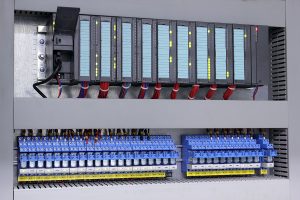The use of computer and computer automation in manufacturing units has multiplied drastically in the last couple of years. Most commoners do not even know the upper layer of the enormous pile of information offered by computer automation. You can learn these facts only when you have operated a programmable logic controller which is known as a PLC.
A PLC machine is a computer which has a processor and the architecture of the machine is such that it is focused at interacting with the outside world. The inputs of information are received by it in the form of digital and analog sensors, relays and a number of other gadgets. The outputs to the real world are in the form of motors, valves, conveyor belts, actuators and others.
PLC is at the core of all this input and output activity. The programming of PLC makes decisions according to the inputs from the outside world and then within fractions of seconds provides outputs to the real world. We know these machines by the common name of robots.
The Creation of Computer Automation Programming
Before the age of computers, manufacturing systems were operated manually. It meant that a human being was required to run the machines – start and stop them and operate them in a particular manner. This was essentially the initial stage of automation which replaced humans.
The evolution of PLC programming resulted by studying the way in which these manual systems were wired. Smart technology was introduced in some places to safeguard the machines and their electrical wiring. There were input push buttons along with output relays to complete the information cycle.
One of them is known as normally open, and the other one is known to be normally closed. These relays could be operated by a limit switch struck by an object or a push button. The following sign was used by electricians to represent an output coil that could turn a motor on or any other device could be turned on or off.
As computer processors came into being along with sensor devices like infrared proximity and level sensors, a lot of these manual processes were replaced by computer automation programming inside high-speed units known as PLCs.
How is a PLC different than a normal computer?
PLCs are much faster at cycling and interacting with the outside world. If you look at an image of an Allen Bradley PLC system, it will be surprising that only the module at the very left is the computer. The rest of the machine consists of modules that interact with input devices or sensors, and there are also modules which control the output devices.
The control language of these systems had to be understood by electricians as these systems are being used more and more and that is how ladder logic was created.
Ladder Logic Use in Computer Automated Programming
Although this is likely to change soon, till now different versions of ladder logic are used in PLCs. Ladder Logic is a programming language which appears very similar to the old versions of electrical diagrams and electrical symbols, but in fact, it is placed inside the processor in the form of a sequential program which controls things.
The looks of this PLC programming are like an electrical schematic, but these symbols simply represent types of function. While the input relays examine sensors in the real world, the output systems are turning off or on a device in the real world. Any boxes in between stand for different mathematical calculations or other functions like any other computer software.
Many rungs are laid out in the program, and each of these rungs is scanned almost simultaneously. Usually, computer programmers are used to writing sequential programs in which the script is processed one line at a time. On the other hand, for writing a program for a PLC, everything is happening all at once, and it can be difficult to get used to this. However, if you look at the speed with which a robot must respond to changes in the real world, then you will understand why this fast scan time is essential.
If you look at the high volumes and precise demands of the world of manufacturing currently, you will be able to understand why the PLCs are at the core of the process that provides a manufacturer with a competitive edge.
If you want to automate any process, you have to understand the process, the machinery and think like a computer programmer so that you can instruct the PLC to be able to do the work that was earlier done by 2-3 human beings.
What’s more, if you use a computer to do these things then you can also take instant measurements, conduct tests and collect data so that the information is available instantly.
